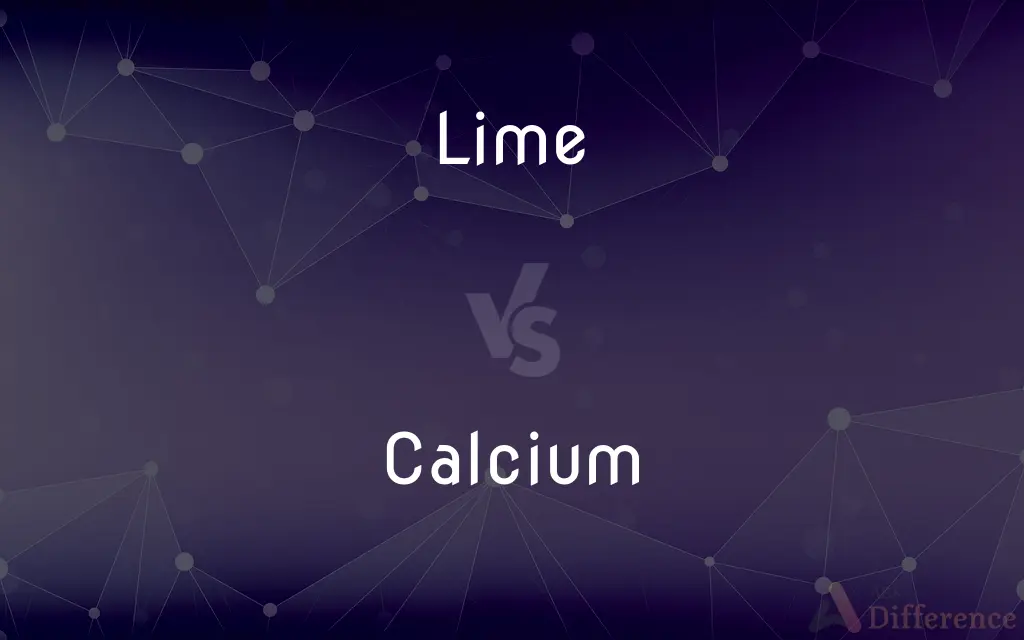Lime vs. Calcium — What's the Difference?
Edited by Tayyaba Rehman — By Maham Liaqat — Updated on March 24, 2024
Lime is a calcium-containing material, while calcium is a chemical element.

Difference Between Lime and Calcium
Table of Contents
ADVERTISEMENT
Key Differences
Lime, commonly known as quicklime or calcium oxide, is derived from limestone and used in various industrial and environmental processes. It's a key ingredient in cement and mortar, while calcium, a silver-white metal, is crucial for biological systems and forms compounds like calcium carbonate and calcium phosphate.
While lime is often used to adjust soil pH and stabilize soil, calcium plays a vital role in building strong bones and teeth in living organisms. Calcium's presence in dietary supplements underscores its importance for human health, whereas lime's application in agriculture and construction reflects its utility in environmental and material contexts.
In the construction industry, lime is valued for its ability to harden and form mortars and plasters, contributing to building durability. On the other hand, calcium compounds are integral in various industries, from the manufacture of glass and paper to serving as dietary supplements for bone health.
The environmental impact of lime includes its use in water treatment and flue gas desulfurization, showcasing its versatility in pollution control. In contrast, calcium's role in biological processes, including muscle function and nerve transmission, highlights its essential nature in life science.
Lime's historical use in traditional building materials and soil treatment connects it with longstanding human practices. Meanwhile, calcium's discovery and utilization in modern science and medicine link it to advancements in health and technology.
ADVERTISEMENT
Comparison Chart
Nature
A compound made primarily of calcium and oxygen.
A chemical element with the symbol Ca.
Uses
In construction, agriculture, and environmental applications.
In dietary supplements, manufacturing, and biological functions.
Importance
Adjusts soil pH, stabilizes soil, and used in building materials.
Essential for bone health, muscle function, and various industrial processes.
Industries
Construction, agriculture, and environmental management.
Health, manufacturing, and scientific research.
Environmental Role
Used in water treatment and pollution control.
Involved in biological processes and ecosystems.
Compare with Definitions
Lime
Composition
Lime, or calcium oxide, is derived from heating limestone.
Calcium
Elemental nature
Calcium is a silver-white metal, important as a dietary requirement.
Lime
Usage in construction
Lime is used to make mortar and plaster in building works.
Calcium
Role in health
Calcium supplements support bone and dental health.
Lime
Environmental benefit
Lime treats wastewater by adjusting pH and removing impurities.
Calcium
Biological importance
Calcium ions are crucial in muscle contractions and nerve functions.
Lime
Historical significance
Lime has been used in construction and agriculture for centuries.
Calcium
Industrial use
Calcium compounds are used in glass and paper manufacturing.
Lime
Agricultural application
Farmers apply lime to soil to improve pH levels and soil health.
Calcium
Scientific relevance
Calcium isotopes are used in geological and medical studies.
Lime
A white caustic alkaline substance consisting of calcium oxide, which is obtained by heating limestone and which combines with water with the production of much heat; quicklime.
Calcium
Calcium is a chemical element with the symbol Ca and atomic number 20. As an alkaline earth metal, calcium is a reactive metal that forms a dark oxide-nitride layer when exposed to air.
Lime
Birdlime.
Calcium
A silvery, moderately hard alkaline-earth metal that constitutes approximately 3.6 percent of the earth's crust and is a basic component of most animals and plants. It occurs naturally in limestone, gypsum, and fluorite, and its compounds are used to make plaster, quicklime, Portland cement, and metallurgic and electronic materials. Atomic number 20; atomic weight 40.08; melting point 842°C; boiling point 1,484°C; specific gravity 1.54; valence 2. See Periodic Table.
Lime
A rounded citrus fruit similar to a lemon but greener, smaller, and with a distinctive acid flavour
Wedges of lime
Lime juice
Roughly chop two limes
Calcium
The chemical element (Symbol Ca), with an atomic number 20. It is a soft, silvery-white alkaline earth metal which occurs naturally as carbonate in limestone and as silicate in many rocks.
Lime
The evergreen citrus tree which produces limes, widely cultivated in warm climates.
Calcium
(countable) An atom of this element.
Lime
A bright light green colour like that of a lime
A lime-green bikini
Calcium
An elementary substance; a metal which combined with oxygen forms lime. It is of a pale yellow color, tenacious, and malleable. It is a member of the alkaline earth group of elements. Atomic weight 40. Symbol Ca.
Lime
A deciduous tree with heart-shaped leaves and fragrant yellowish blossom, native to north temperate regions. The pale timber is used for carving and inexpensive furniture.
Calcium
A white metallic element that burns with a brilliant light; the fifth most abundant element in the earth's crust; an important component of most plants and animals
Lime
An informal social gathering characterized by semi-ritualized talking.
Lime
Treat (soil or water) with lime to reduce acidity and improve fertility or oxygen levels
They were liming acidified lakes
Lime
Catch (a bird) with birdlime
The bird that hath been limed in a bush
Lime
Sit or stand around talking with others
Boys and girls were liming along the roadside as if they didn't have anything to do
Lime
Any of several evergreen trees or shrubs of the genus Citrus having edible green or greenish-yellow fruit, especially the Mexican lime and the Persian lime.
Lime
The fruit of any of these plants, having a pulpy interior and usually acid juice.
Lime
See linden.
Lime
See calcium oxide.
Lime
Any of various mineral and industrial forms of calcium oxide differing chiefly in water content and percentage of constituents such as magnesia, silica, alumina, and iron.
Lime
Birdlime.
Lime
To treat with lime.
Lime
To smear with birdlime.
Lime
To catch or snare with or as if with birdlime.
Lime
(chemistry) Any inorganic material containing calcium, usually calcium oxide (quicklime) or calcium hydroxide (slaked lime).
Lime
(poetic) Any gluey or adhesive substance; something which traps or captures someone; sometimes a synonym for birdlime.
Lime
(theatre) A spotlight.
Lime
A deciduous tree of the genus Tilia, especially Tilia × europaea; the linden tree.
Lime
The wood of this tree.
Lime
Any of several green citrus fruit, somewhat smaller and sharper-tasting than a lemon.
Lime
Any of the trees that bear limes, especially Key lime, Citrus aurantiifolia.
Lime
(uncountable) A brilliant, sometimes yellowish, green colour associated with the fruits of a lime tree.
Lime
A casual gathering to socialize.
Lime
(transitive) To treat with calcium hydroxide or calcium oxide (lime).
Lime
(transitive) To smear with birdlime.
Lime
(rare) To ensnare, catch, entrap.
Lime
(transitive) To apply limewash.
Lime
To hang out/socialize in an informal, relaxed environment, especially with friends, for example at a party or on the beach.
Lime
Containing lime or lime juice.
Lime
Having the aroma or flavor of lime.
Lime
Lime-green.
Lime
A thong by which a dog is led; a leash.
Lime
The linden tree. See Linden.
Lime
The fruit of the Citrus aurantifolia, allied to the lemon, but greener in color; also, the tree which bears it.
Lime
The color of the lime{1}, a yellowish-green.
Lime
Birdlime.
Like the limeThat foolish birds are caught with.
Lime
Oxide of calcium, CaO; the white or gray, caustic substance, usually called quicklime, obtained by calcining limestone or shells, the heat driving off carbon dioxide and leaving lime. It develops great heat when treated with water, forming slaked lime, and is an essential ingredient of cement, plastering, mortar, etc.
Lime
To smear with a viscous substance, as birdlime.
These twigs, in time, will come to be limed.
Lime
To entangle; to insnare.
We had limed ourselvesWith open eyes, and we must take the chance.
Lime
To treat with lime, or oxide or hydrate of calcium; to manure with lime; as, to lime hides for removing the hair; to lime sails in order to whiten them; to lime the lawn to decrease acidity of the soil.
Land may be improved by draining, marling, and liming.
Lime
To cement.
Lime
Having a yellowish-green color like that of the lime (the fruit).
Lime
A caustic substance produced by heating limestone
Lime
A white crystalline oxide used in the production of calcium hydroxide
Lime
A sticky adhesive that is smeared on small branches to capture small birds
Lime
Any of various related trees bearing limes
Lime
Any of various deciduous trees of the genus Tilia with heart-shaped leaves and drooping cymose clusters of yellowish often fragrant flowers; several yield valuable timber
Lime
The green acidic fruit of any of various lime trees
Lime
Spread birdlime on branches to catch birds
Lime
Cover with lime so as to induce growth;
Lime the lawn
Common Curiosities
What is calcium?
Calcium is a chemical element essential for bone health, muscle function, and numerous industrial processes.
What is lime?
Lime, or calcium oxide, is a compound used in building materials, agriculture, and environmental applications.
Why is calcium important for health?
Calcium is vital for building strong bones and teeth, and it's crucial in muscle function and nerve transmission.
What industries rely on lime?
The construction, agriculture, and environmental sectors frequently use lime in various applications.
How is lime used in construction?
Lime is used to make mortar and plaster, contributing to the durability of buildings.
Can lime affect soil health?
Yes, lime can improve soil health by adjusting pH levels, making nutrients more available to plants.
How is lime produced?
Lime is produced by heating limestone (calcium carbonate) in a kiln, a process that drives off carbon dioxide to leave calcium oxide.
How does calcium support biological functions?
Calcium ions play a key role in biological processes, including blood clotting, muscle contractions, and nerve functions.
How does calcium affect muscle function?
Calcium ions trigger muscle contractions by interacting with proteins in muscle cells.
Are calcium supplements beneficial?
Calcium supplements can be beneficial, especially for individuals at risk of bone-related conditions.
Is lime environmentally friendly?
Lime can be environmentally beneficial, particularly in water treatment and pollution control.
Where is calcium found in nature?
Calcium is found in various minerals, such as limestone, gypsum, and fluorite, and is abundant in the Earth's crust.
What foods are high in calcium?
Dairy products, leafy greens, and fortified foods are high in calcium.
Can lime be used in water treatment?
Yes, lime is used in water treatment processes to adjust pH and remove impurities.
Is lime the same as limestone?
No, lime (calcium oxide) is produced from limestone (calcium carbonate) through a heating process that removes carbon dioxide.
Share Your Discovery

Previous Comparison
Ranger vs. Hunter
Next Comparison
Photonics vs. OpticsAuthor Spotlight
Written by
Maham LiaqatEdited by
Tayyaba RehmanTayyaba Rehman is a distinguished writer, currently serving as a primary contributor to askdifference.com. As a researcher in semantics and etymology, Tayyaba's passion for the complexity of languages and their distinctions has found a perfect home on the platform. Tayyaba delves into the intricacies of language, distinguishing between commonly confused words and phrases, thereby providing clarity for readers worldwide.














































